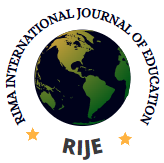Effects of Drill and Practice and Conventional Method on Hausa Language Students’ Performance and Retention in Daura Educational Zone, Katsina State, Nigeria
Abdullahi Ismaila Abubakar, Badamasi Alka, Hassan Mamman & Auwal Adamu
1Department of Curriculum Studies, Sokoto State University, Sokoto, Nigeria. Email: abdullahi.ismailabubakar@ssu.edu.ng
2Katsina State Ministry of Basic Science and Secondary Education, Katsina State, Nigeria. Email: badamasialka86@gmail.com
3Department of Curriculum and Instruction, Umar Suleiman College of Education, Gashua, Yobe State, Nigeria. Email: hassanmamman333@gmail.com
4Department of Curriculum Studies, Jigawa State College of Education, Gumel, Jigawa State, Nigeria. Email: auwaladam73@gmail.com
Abstract
The study investigates the Effects of Drill and Practice and conventional methods on Hausa language students’ academic performance and retention in Daura Educational Zone, Katsina State, Nigeria. The study stated that two research objectives, research questions, and hypotheses were formulated. The study used a quasi-experimental research design of pre-test, post-test, non-equivalent, non-randomize control group design. The population of the study was 3,912 SSII Hausa language students in Daura Educational Zone, Katsina State. 101 SS II Hausa language students used purposive sampling to participate in the study. The study used the Hausa Language Achievement Test for data collection. The Hausa language Achievement Test was made up of 40 multiple-choice questions. The instrument was adapted from past questions in the West Africa Examination Council (WAEC). Experts validated the instrument. The reliability of the instruments was established using a test-retest method and a reliability coefficient of 0.669 was obtained. The experimental group was taught using the Drill and practice method while a control group was taught using the conventional method of teaching. The study research questions were answered using mean and standard deviation while the formulated hypotheses were tested using an independent sample t-test. This study findings show a significant difference in the academic performance of senior secondary school students taught the Hausa Language using drill and practice and those taught using the conventional method in favour of the drill and practice method. The study revealed that there was a significant difference between the retention score of students taught the Hausa language using Drill and Practice and those taught using the conventional method in favour of drill and practice group. Also, there was a significant difference in the academic performance of male and female students taught the Hausa language using drill and practice methods. Based on the findings of this study, the study concluded that the drill and practice method can improve students’ academic performance and retention in the Hausa language. But it was more favourable to male students. Thus, based on the findings of this study, it was recommended that the Hausa language teachers should use the Drill and practice method to stimulate and boost Hausa language students’ academic performance and retention at the senior secondary school level.
Keywords
Computer Assisted Instruction (CAI), Drill and Practice, Conventional Method
Reference
Adebisi, A. M. Tayibat D. B., & Solomon, O. A. (2014). Impact of computer assisted-instruction on students’ academic achievement in Biology in Ilorin West, Kwara, Nigeria, US-China Education-Review, 4 (7), 509-516.
Achor, E. E. Otor, E .E.,&Umoru, O. W. (2013). Information communication and technology (ICT) for the effective management of secondary schools for sustainable development in Ekiti State, Nigeria. American-European Journal of Scientific Research, 5 (2), 106-113.
Bada, T. (2009).Uses of computers and its relevance to teaching and learning in the Nigerian educational system. http://www.academijournals.org/ERR.
Bichi S. S. (2010). The effect of gender on academic achievement in evaluating concepts among secondary school students using problem-solving strategy in Zaria. Journal of Studies in Education, 3 (1), 132-138.
Chang, J. C. (2006). A field test of computer-assisted instruction software: Magic Tree Masters Abstracts International Journal, 38(6) 14-38(UMI NO. 1399856)
Christman, E. P. & Badgett, J. L. (2006). The comparative effectiveness of computer-assisted instruction on collegiate academic performance. Journal of Computing in Higher Education, 11(3), 91-1106.
Mudasiru, O. Y. & Adedeji, O. A. (2010). Effect of computer-assisted instruction (CAI) on secondary school students’ performance in Biology. The Turkish Journal of Educational Technology 9(1).
Azikiwe, U. (2008). Language teaching and learning. Onitsha: Feb. Publishers Limited.
Denby, D. & Holman, J. (2006). ICT in support of Science Education: a practical guide. New York Publishing Service, America.
Federal Republic of Nigeria (2014). National policy on education (revised), NERC Press, Lagos.
Hussaini, L. & Ali, U. (2011). Role of computer-assisted instruction on the interest and retention of students of secondary school level. Academic Research International, 3 (2) 65-79
Kareem, A.A., (2015). Effect of computer-assisted instruction on student academic achievement and attitude in Biology in Osun State Nigeria. Journal of Emerging Trends in Educational Research and Policy Studies (JETETRAPS), 6 (1), 69-73.
Seosa, Y., & Brayant, P. (2017). Analysis of the study of the effects of computer-assisted instruction on the mathematics performance of students with learning disabilities. Journal of Computer & Education, 53 (4) 913-928.
Santrock, J. W. (2004). Educational Psychology. McGraw-Hill.
Schunk, D. H. (2012). Learning theories: an educational perspective (6th ed.). Pearson.
Sousa, D. A. (2017). How the brain learns (5th ed.). Corwin Press.
Seo, Y., & Brayant, P. (2009). Analysis of the study of the effects of computer-assisted instruction on the mathematics performance of students with learning disabilities. Journal of Computer & Education, 53 (4) 913-928.
Yusuf, M. O. & Afolabi, A. O., (2010). Effect of computer assisted instruction (CAI) on secondary school students’ performance in Biology. The Turkish Online Journal of Educational Technology, 3 (12), 60- 90.
